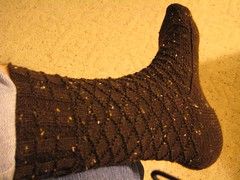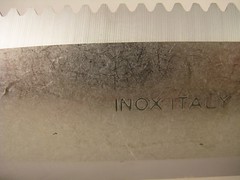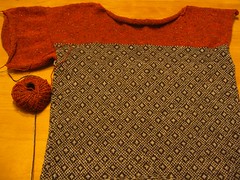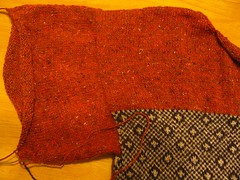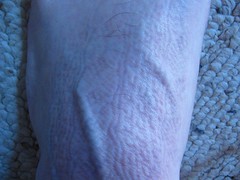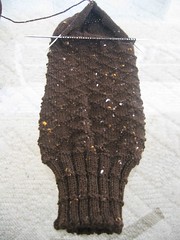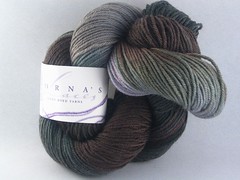Let's call the whole thing bound off. Or the first half of it, anyway.
I finished the first of the pair of Gentleman's Sock with Lozenge Pattern from Nancy Bush's Knitting Vintage Socks tonight. I had one of those nice moments yesterday evening when, thinking I had rows and rows to go but stopping to count, I found I was ready for the toe decrease. All I had to do tonight was Kitchener-stitch the toes. Done!
I took the finished sock and the remains of the ball of yarn to the scale. Yes, you guessed it. 1.9 ozs. each. You would think I live for the danger of knitting on the edge like this, but it really does work my nerves. So I've got a whole sock's worth of anxiety ahead of me.
I'm having some thoughts about the British Checks sweater. The arm (as noted by one of my fellow knitters last weekend) is really quite large circumference-wise. I thought it would shake out with the decreases, but I nearly finished the first sleeve and it's still big enough to fit two arms in. In fact, most of the ginger section has a looseness and bagginess to it that I just don't like. I'm seriously thinking of frogging all the orange parts and trying again on smaller needles. It wouldn't take that long...
I should rename this sweater the biscotti sweater, because it's nearly been twice-baked. In any case, Silas likes it. He's usually a good boy and rarely gets on the furniture while we're out of the house, but every once in a while he gets the urge. And tonight the chair he chose was the one with the sweater piled in it. It was quite warm -- and well-pressed -- when we got home from our walk this evening. This picture was snapped during his perp walk.
Wednesday, January 30, 2008
Sunday, January 27, 2008
Inoxydable
Now THAT'S a knitting needle!
Not really. In actuality, it's something called a soil knife. In a conversation about weeding my new landscaping that I had with a colleague at work last week, it was suggested that I get a soil knife. It's kind of like a garden trowel, except thinner and sturdier. And it has those menacing serrated teeth on one edge. And it comes with swashbuckly scabbard-sheathy thing from which one can withdraw it as one stalks unwanted flora. Eye-patch not included.
So imagine my knitterly surprise when I looked at the writing on the blade. It reads INOX ITALY. Right there on the metal. Many knitters will be familiar with the Inox brand of enameled metal knitting needles, which I believe (but am not sure) are made in Germany. They are very smooth and make a pleasant (or annoying, depending on whether you are me or Jeff) clinking noise as you work with them, especially if you are using the double-pointed variety.
So, I thought -- how is it that a company could make knitting needles AND blades for soil knives? I dug around on the internets, finding all kinds of references to European companies that made ball bearings, fitting rings, cookware, countertop surfaces -- all referring to Inox. Then, I finally stumbled across a page that explained -- Inox is short for "inoxidable" -- or something which cannot be oxidized -- usually in the context of acier inoxydable(Fr.) or stainless steel, basically. Which makes sense. And which everyone in the knitting community probably knew, except me.
Not really. In actuality, it's something called a soil knife. In a conversation about weeding my new landscaping that I had with a colleague at work last week, it was suggested that I get a soil knife. It's kind of like a garden trowel, except thinner and sturdier. And it has those menacing serrated teeth on one edge. And it comes with swashbuckly scabbard-sheathy thing from which one can withdraw it as one stalks unwanted flora. Eye-patch not included.
So imagine my knitterly surprise when I looked at the writing on the blade. It reads INOX ITALY. Right there on the metal. Many knitters will be familiar with the Inox brand of enameled metal knitting needles, which I believe (but am not sure) are made in Germany. They are very smooth and make a pleasant (or annoying, depending on whether you are me or Jeff) clinking noise as you work with them, especially if you are using the double-pointed variety.
So, I thought -- how is it that a company could make knitting needles AND blades for soil knives? I dug around on the internets, finding all kinds of references to European companies that made ball bearings, fitting rings, cookware, countertop surfaces -- all referring to Inox. Then, I finally stumbled across a page that explained -- Inox is short for "inoxidable" -- or something which cannot be oxidized -- usually in the context of acier inoxydable(Fr.) or stainless steel, basically. Which makes sense. And which everyone in the knitting community probably knew, except me.
Thursday, January 24, 2008
Sew Its Seams
That was one of the instructions (but not the exact wording) on the British Checks Sweater. Sewing seams is the part of projects I dread. It usually involves sitting at the kitchen table for a day or more, hunched over the pieces of my sweater and looking like Motl the Tailor before he got his newfangled sewing machine. The whole process makes my back hurt and makes me cranky -- and I never quite feel like I'm doing it right. But not this time.
This time, since this is all knit in the round, the sewing only involved 47 stitches on each shoulder. That was it. Straightforward horizontal seaming -- go under the first stitch on the bottom half, go under the corresponding stitch above. Still somewhat easy to lose one's place, but no grueling task either. I was pretty happy with how they turned out.
But life is all about the trade-offs right? I may have dodged the nemesis called Seaming, but I came face-to-face with her evil twin, Picking up Stitches. Groan. This is one of those skills that I've gotten better at over time, but I'm still not eager to do it. I'm waiting for the day that I just do it effortlessly without gritting my teeth and steeling my nerve before jumping in.
The sleeves called for picking up 136(!) stitches. So I divided that in two and figure out each side of the sleeve (front and back) would require 68 stitches. The pattern said that the armhole should be 10.25 inches long -- which mine was (woo-hoo!). Then I divided that in half and placed a safety pin ( note to self -- get real big-boy stitch markers some day) -- 34 stitches on either side of that. Then I divided again to get four 17-stitch sections on each side. That made things more manageable.
However, not all selvedge edges are created equal. In the ginger-colored sections, I had about as many edge stitches as I needed to get 17. Usually, instructions for picking up stitches along the edge will say something like, "pick up three stitches for every four selvedge edge stitches." So picking up one for each edge stitch seemed a bit crowded -- and I think the picture shows that. Probably has something to do with not getting row gauge in this section.
On the stranded part, the instructions had me slip the edge stitches, so I had to find 17 stitches in a place where I only had a dozen slipped edge stitches. I ended up going in a row for the picking up. I think I did mostly okay. I continue to put my faith in the miracle of blocking.
When it came to the decreases for the sleeves, the instructions were a little ambiguous. Without giving too much design information away, It said to "decrease every 5th rounds x(0,0,0) times; every 4th round 0(x,x,x)times; every 2nd round x(x,x,x) times. It seemed like the 5th and 4th round decreases were concurrent (if you did the small size you did every 5th and all other sizes every 4th), but I couldn't figure out the last part. I remembered that I'd seen the designer's site on Ravelry, so I sent her a message and she very graciously (and quickly) responded. Turns out the editors had left out the word "then" before the every-2nd-round instructions. Small word, big difference. But all is clear now. Thank you, Ms. Spurkland!
So for now, it's round and round. On two circular needles because I didn't have needles small enough to do it on one and I'm too lazy to go buy new dpns.
This time, since this is all knit in the round, the sewing only involved 47 stitches on each shoulder. That was it. Straightforward horizontal seaming -- go under the first stitch on the bottom half, go under the corresponding stitch above. Still somewhat easy to lose one's place, but no grueling task either. I was pretty happy with how they turned out.
But life is all about the trade-offs right? I may have dodged the nemesis called Seaming, but I came face-to-face with her evil twin, Picking up Stitches. Groan. This is one of those skills that I've gotten better at over time, but I'm still not eager to do it. I'm waiting for the day that I just do it effortlessly without gritting my teeth and steeling my nerve before jumping in.
The sleeves called for picking up 136(!) stitches. So I divided that in two and figure out each side of the sleeve (front and back) would require 68 stitches. The pattern said that the armhole should be 10.25 inches long -- which mine was (woo-hoo!). Then I divided that in half and placed a safety pin ( note to self -- get real big-boy stitch markers some day) -- 34 stitches on either side of that. Then I divided again to get four 17-stitch sections on each side. That made things more manageable.
However, not all selvedge edges are created equal. In the ginger-colored sections, I had about as many edge stitches as I needed to get 17. Usually, instructions for picking up stitches along the edge will say something like, "pick up three stitches for every four selvedge edge stitches." So picking up one for each edge stitch seemed a bit crowded -- and I think the picture shows that. Probably has something to do with not getting row gauge in this section.
On the stranded part, the instructions had me slip the edge stitches, so I had to find 17 stitches in a place where I only had a dozen slipped edge stitches. I ended up going in a row for the picking up. I think I did mostly okay. I continue to put my faith in the miracle of blocking.
When it came to the decreases for the sleeves, the instructions were a little ambiguous. Without giving too much design information away, It said to "decrease every 5th rounds x(0,0,0) times; every 4th round 0(x,x,x)times; every 2nd round x(x,x,x) times. It seemed like the 5th and 4th round decreases were concurrent (if you did the small size you did every 5th and all other sizes every 4th), but I couldn't figure out the last part. I remembered that I'd seen the designer's site on Ravelry, so I sent her a message and she very graciously (and quickly) responded. Turns out the editors had left out the word "then" before the every-2nd-round instructions. Small word, big difference. But all is clear now. Thank you, Ms. Spurkland!
So for now, it's round and round. On two circular needles because I didn't have needles small enough to do it on one and I'm too lazy to go buy new dpns.
Saturday, January 19, 2008
Ginger Snapped
Today, I finished the back part of the British Checks Sweater, completing the first ginger section. So I thought I'd take some snaps. The first picture shows the outside, and the second picture shows the inside.
In the pattern, the stranded section continues on a few inches into the armhole part of the sweater. This stranded section is knit flat rather than in the round. Knitting stranded flat is like learning to knit all over again. I had finally gotten used to knitting continental on the left with the light color and throwing with my right with the light color -- now I have to do this with purling? Throwing purls (I like the way that sounds!) was painful and bad. My gauge changed. And, horror of horrors, it appears that the yarn dominance changed.
I may have mentioned this before, but when knitting with two strands of yarn, the strand that is carried lower along the back of the work will stand out more on the front. I'm no sure why, but I think it has something to do with the lower-strand taking more yarn and thus appearing larger than it's upper-strand neighbors.
Throughout the section knit in the round, I kept the lighter color in my left hand, which ran below the darker color carried in my right hand. The lighter color had dominance. I continued to do this while knitting flat, but the dominance seems to have shifted. For the last two inches or so of the stranded pattern, the darker color stands out more. You kind of have to look for it, but it's noticeable -- kind of like working with a different dye lot. Let's just say Jeff can see it.
Do you think switching hands with the color would fix this? I just don't know and haven't been able to find out anything about this. In any case I won't be doing this, because I'm not going to reknit the back. In fact, I'm going to try and make sure I do the dominance shift on the front side, too. I'm worried that when I try to, I won't be able to. We'll see.
And now a little something bizarre that sock knitters will appreciate. This afternoon when I took off a cabled sock that I made several years ago, I saw this hilarious pattern that had been imprinted on the top of my foot. If you click on the picture and go to my Flickr site, you can see notes that point out the different pattern areas.
I'm not sure why I felt compelled to share this. I hope you don't find it too disturbing.
In the pattern, the stranded section continues on a few inches into the armhole part of the sweater. This stranded section is knit flat rather than in the round. Knitting stranded flat is like learning to knit all over again. I had finally gotten used to knitting continental on the left with the light color and throwing with my right with the light color -- now I have to do this with purling? Throwing purls (I like the way that sounds!) was painful and bad. My gauge changed. And, horror of horrors, it appears that the yarn dominance changed.
I may have mentioned this before, but when knitting with two strands of yarn, the strand that is carried lower along the back of the work will stand out more on the front. I'm no sure why, but I think it has something to do with the lower-strand taking more yarn and thus appearing larger than it's upper-strand neighbors.
Throughout the section knit in the round, I kept the lighter color in my left hand, which ran below the darker color carried in my right hand. The lighter color had dominance. I continued to do this while knitting flat, but the dominance seems to have shifted. For the last two inches or so of the stranded pattern, the darker color stands out more. You kind of have to look for it, but it's noticeable -- kind of like working with a different dye lot. Let's just say Jeff can see it.
Do you think switching hands with the color would fix this? I just don't know and haven't been able to find out anything about this. In any case I won't be doing this, because I'm not going to reknit the back. In fact, I'm going to try and make sure I do the dominance shift on the front side, too. I'm worried that when I try to, I won't be able to. We'll see.
And now a little something bizarre that sock knitters will appreciate. This afternoon when I took off a cabled sock that I made several years ago, I saw this hilarious pattern that had been imprinted on the top of my foot. If you click on the picture and go to my Flickr site, you can see notes that point out the different pattern areas.
I'm not sure why I felt compelled to share this. I hope you don't find it too disturbing.
Saturday, January 12, 2008
I Resolve...
...to knit more and then post about it. Sounds simple, eh? I've been doing quite a bit of knitting, actually, I just haven't been in the writing mood. The semester got off to a fast start and we've been very busy around here.
I did get most of the body of the British Checks Sweater re-knit. Just a few more rounds to go. I tried it on Jeff again. We don't have a halter-top this time, but things are still a little snug. I think I'm within the blocking zone this time, so I'm not going to re-knit it yet again. I think I'd go insane. Me and gauge -- we are destined to be eternal enemies, it seems.
I've also been picking up the Gentleman's Sock with Lozenge Pattern, AKA the Pineapple Socks, from time to time. Yesterday and today I knit the heel flap and this morning I finished turning the heel and have gotten started on the gusset decreases. The instructions say to keep the lozenge pattern going -- something like "continue pattern on needles 2." I like how Ms. Bush assumes that by now you've figured this out and don't need row-by-row instructions on how to keep the pattern going. In some cases, this type of vagueness would freak me out, but I seem to be in sync with Nancy on this one. Feels nice. So far so good.
Oh, and I did a bit of stash enhancement last weekend. My knitting friend Melissa was knitting with some of this, and I just had to get my hands on it. It's Lorna's Laces Shepherd Sock (which I always love) in the colorway "Mineshaft." Intriguing, to say the least! The Knitting Nest had two hanks left, and I snatched them up. I love Lorna's Laces sock yarn (see this and that), I love darker colors, and I can't wait to give this a try.
I did get most of the body of the British Checks Sweater re-knit. Just a few more rounds to go. I tried it on Jeff again. We don't have a halter-top this time, but things are still a little snug. I think I'm within the blocking zone this time, so I'm not going to re-knit it yet again. I think I'd go insane. Me and gauge -- we are destined to be eternal enemies, it seems.
I've also been picking up the Gentleman's Sock with Lozenge Pattern, AKA the Pineapple Socks, from time to time. Yesterday and today I knit the heel flap and this morning I finished turning the heel and have gotten started on the gusset decreases. The instructions say to keep the lozenge pattern going -- something like "continue pattern on needles 2." I like how Ms. Bush assumes that by now you've figured this out and don't need row-by-row instructions on how to keep the pattern going. In some cases, this type of vagueness would freak me out, but I seem to be in sync with Nancy on this one. Feels nice. So far so good.
Oh, and I did a bit of stash enhancement last weekend. My knitting friend Melissa was knitting with some of this, and I just had to get my hands on it. It's Lorna's Laces Shepherd Sock (which I always love) in the colorway "Mineshaft." Intriguing, to say the least! The Knitting Nest had two hanks left, and I snatched them up. I love Lorna's Laces sock yarn (see this and that), I love darker colors, and I can't wait to give this a try.
Subscribe to:
Comments (Atom)
